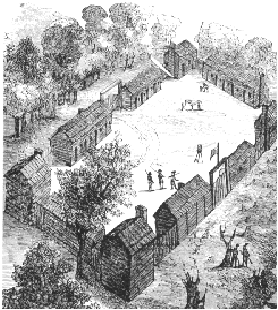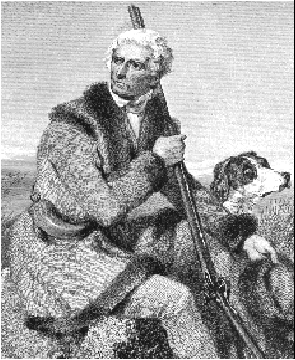|
|
|
Boonesboro |
|
 |
James served three tours with the Virginia Militia. The first was in
1778. In his pension request, he wrote "In the early part of February,
1778, a short time after Daniel Boone was taken prisoner by the
Indians at the Salt Licks in Kentucky, I volunteered under Capt.Thomas
Dillard of Pittsylvania County, Lt. Thomas Hutchins and Ensign Charles
Hutchins to go to Kentucky to fight the Indians."
Boone's biography on Wikipedia states, "On 7 February
1778, when Boone was hunting meat for the expedition, he was surprised
and captured by warriors led by Blackfish. Because Boone's party was
greatly outnumbered, he convinced his men to surrender rather than put
up a fight.
The Virginia State Archives has no record of this expedition,
but militia units were quickly formed bands of farmers-turned-soldier,
usually assembled for a single task and disbanded when it was
completed. For all practical purposes, they kept no records, making it
difficult for historians to even establish a unit's existence, much
less its history.
Maud Clement in her History of Pittsylvania County, Virginia, wrote, "In
January 1778, Pittsylvania sent several companies of militia again to
the frontier. Captain Thomas Dillard and Lieutenant Charles Hutchings
commanded a company that marched direct from Pittsylvania to Issac
Riddle's house, twelve miles above the Long Island on the Holstein. thence to Boonesboro,
Kentucky, where they were stationed three months."
Interestingly, she has the militia leaving for Boonesboro before Boone
was captured by the Indians.. |
| Revolutionary War Pension Requests
provide such a wealth of historic and genealogical information that in
1958 genealogist and historian Fred Dorman began abstracting and publishing those based on
Virginia service. Now, 35 years later, he has completed them through the
pension of Elijah Green (Vol. 45). In hopes of obtaining more detail
about the Boonesboro expedition, the indexes of all forty five volumes
were searched for people, places and events mentioned by James in his
pension application. It resulted in a wealth of detail, not found in
history books. Many of the old soldiers were illiterate, so they
narrated their accounts to others who wrote them down. That
information was used to compile this account. |
The brightly dressed professional army of English "redcoats" faced rag
tag bands of green recruits that made up the newly formed Continental
Army. The two armies fought more or less conventional battles, but
along the western frontier, the English conspired with Indian tribes
to attack remote American settlements. The strategy was simple: make
the colonies commit troops to settlement defense so that they could
not be used against the regular British army. Virginia then extended
from the Atlantic Ocean to as far west as present day Illinois,
Indiana, and Ohio. She was particularity vulnerable. One British
target was the small settlement of Boonesboro in Virginia's western county of Kentucky.
It was not Dillard's first command. John
Collyer had enlisted under him on March 10, 1775; Barret Franks simply
wrote that it was in the spring. The company rendezvoused at Murdock's
Store and marched to Williamsburg where they met 1,200 regulars under
Taylor.
In April 1777, Capt. Henry Paulding of
Botetourt County raised about a hundred militia for the defense of
Boonesboro. Three months later, Capt. Charles Watkins provided another
fifty men from Bedford County; his volunteers included James and Micajah
Calloway. When their terms expired, they volunteered to remain in
Kentucky under the command of Col. Daniel Boone. Captain Watkins'
volunteers included Ansel Goodman, who described Boonesboro as a fort or
station on the Kentucky River. Goodman reported: |
| Some considerable time after being so employed upon
constant duty and very short allowance, me and about thirty others under
Col. Boone were ordered out upon an expedition to make salt for the use
of those in the fort. We marched to a place about seventy or eighty
miles from the fort, then and now called the Blue Licks. After being
there about three weeks engaged in making salt, Col. Boone was absent
from the company hunting and trapping when a party of the Shawnees, of
about one hundred Indians commanded by their chief, Black Fish, fired
several guns at him, as Boone told me later. They ran him some distance
and Boone discovered he would be taken, so he stopped, put his gun
behind a tree, stepped out and gave up. The Indians then marched with
Col. Boone to where the balance of us were and we were ordered by Col.
Boone to stack our guns and surrender. We did so. |
|
Achilles Eubank was one of Captain Watkins' volunteers. When news that
Boone and twenty seven other men were captured reached the fort, he "was
immediately dispatched to Virginia as an express in company with Squire
Boone."
|

Daniel Boone |
|
After a few days, they marched to Gwynn's Island where they guarded against Negroes joining Dunsmore
under his proclamation that offered them freedom from slavery if they
would fight with the British. Collier wrote
that after Dunsmore was defeated, Dillard's company marched back to
Pittsylvania county where he was discharged in late August, 1775. Franks
never mentioned the return to Pittsylvania, but stated that they then
went to the western borders of Virginia "to repel the hostile
incursions of the Cherokee Indians who had assembled in great bodies in
the borders and at the Long Island, now Tennessee."
Two of James Broyhill's
fellow Pittsylvania County militiamen were Elisha Collins and Thomas
Faris. Collins also entered service in February 1778, and described the
unit as "the Illinois Expedition." Faris enlisted "early
in the year," to guard the fort and inhabitants of Boonesboro.
Collins declared that they arrived in Boonesboro about the middle of
March. James Broyhill wrote, "We were employed in scouting and
skirmishing with the Indians until June." He then marched home and
arrived back in Pittsylvania County about the first of July. James
stated that he received no discharge, and was probably carried on the
Company Muster Rolls under the name James Bray, instead of James
Broyhill his proper name, as he was frequently called by the name of
Bray. Collins and Faris remained in Boonesboro until June 5th.,
when they marched to the Falls of the Ohio River, where they were
attached to Capt. John Montgomery's company, under the command of Col.
George Rogers Clark. "The captain [Dillard], being sick, turned
back and it was his wish to have returned home but Col. Clark, by
persuasion and promises, succeeded in persuading him to go with him to
chastise the Illinois Indians and a governor who was the great cause of
the massacres on our frontiers."
Apparently the unit had
been initially formed in January as an Illinois Expedition to serve
under Clark, but when news of Boone's surrender reached Virginia, it was
diverted to Boonesboro. Collins was the only one of the three men who
had originally volunteered to go to Illinois. Both James Broyhill and
Thomas Faris volunteered after news of Boone's capture. |
|